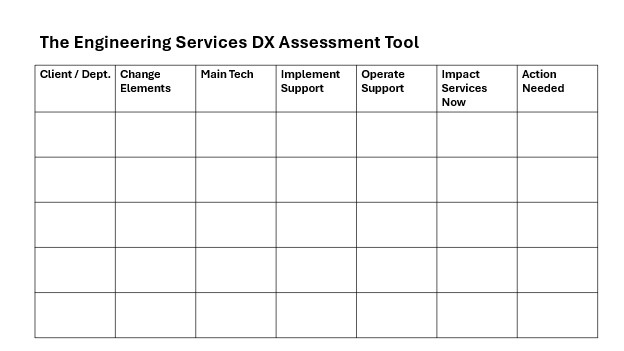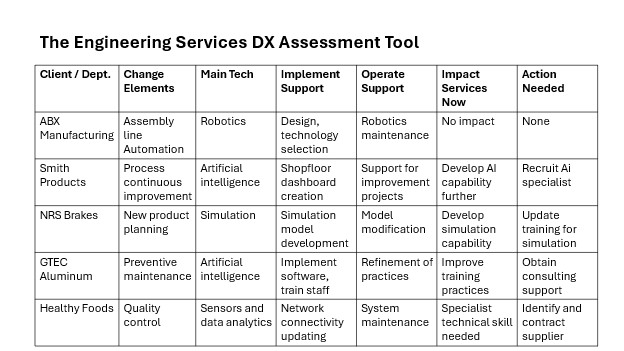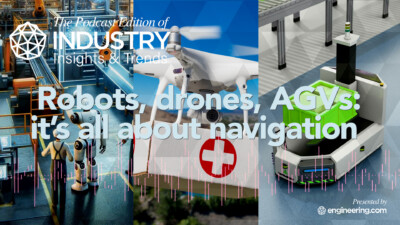It's ironic that the Engineering Services DX Assessment Tool, a simple instrument developed at the University of Waterloo, is low-tech as it gets.
Charlie Patel’s family had been providing engineering services to manufacturing companies in Ontario for the past 75 years. Over that period, technological advance had taken place and resulted in improvements in many aspects of their clients’ activities. These technology changes had occurred at a pace that Charlie’s company had been able to adapt to without too much difficulty – today was different.
Charlie is considering what his company’s response should be to today’s rapid technological change, including what they should do about artificial intelligence. He was hearing about the revolutionary impact AI would have on what seemed a daily basis. He knew that new companies were becoming established that provided new technology-based manufacturing engineering services and he wanted to ensure that this did not result in a reduction in the work done by his company. Charlie needed to understand the impact that these new technologies would have on his business and what his strategy should be to deal with it.
Digital transformation is the response that organisations are making to the Fourth Industrial Revolution (the world created by the rapid technological advance that is taking place today). This can mean changes in products, services and processes throughout the organisation. It can be small or large scale, radically changing business models and it means new technologies are being introduced throughout organisations with significant implications for engineering services organisations.
Engineering services are impacted by the new environment they need to support and the new tools that are available to them to do this. A wide range of technologies may be adopted in the organisation in areas that are within the scope of the work normally done by engineering services. These might include the development, implementation and support for new technology enabled processes, new automation and new decision-making systems that may or may not utilise artificial intelligence.
At the same time, technology is changing the support engineering services provide. More data is being collected and better tools exist that can be used in predictive maintenance services. New design tools enable faster, better design, some aspects of service delivery can be automated, artificial intelligence can be used for analytics, digital twins and simulation support analytics, design and management and big data can provide valuable insights.
These developments in the environment engineers support and in the tools available to them are the main factors influencing the digital transformation of engineering services. They make it essential that engineering services organisations carefully review their current situation and develop their own strategy for dealing with it. Otherwise they will be vulnerable to other providers who emerge, better prepared for the new environment.
The Engineering Services DX Assessment Tool is a simple instrument that we have developed at the University of Waterloo to help engineering services organisations consider and plan their own digital transformation. It is intended to be facilitative – prepared on a white board or flip chart by a group of engineers. Here is a blank version:

The tool is suitable for engineering services companies and engineering services within an existing organisation. It asks you to consider the following elements:
Client/Dept: The main organisations or units the engineering services are provided to. For an engineering services company this may be their main clients or client types if they are larger. For internal engineering services this would be the units they provide services to.
Change Elements: The changes in the Client/Dept that are or will be impacted by new technology. This may be specific performance improvements, equipment changes, process changes etc.
Main Tech: The main technologies being used in the change elements. This may include internet of things, artificial intelligence, digital twins, automation etc.
Implement Support: The support needed to implement the change described in the Change Elements column, such as design work, project management, impact assessment, etc.
Operate Support: The support needed to operate the change described in the Change Elements column, such as maintenance, education and training, and performance improvement.
Impact Services Now: Can your existing services provide the Implement and Operate Support that the Change Elements need now or are changes required to do this? Include here any areas of your services that may have been used by the client in the past but are not now needed due to the Change Element.
Action Needed: Review the information you have entered in this row of the chart and determine the actions that you need to take to deliver the support that your Client/Dept will require.
Charlie has completed the tool for his company, in this example:

The Engineering Services DX Assessment Tool allows you to consider the actions you might wish to take to ensure your organisation is able to continue to effectively provide engineering support. Once the chart is completed you can then consider the areas that will be your priority and become the main elements in your digital transformation strategy.
This strategy must include the impact that the Client/Dept changes will have on the skills of the members of your engineering team, along with any personnel changes you may need to make. The Client/Dept changes will require engagement and collaboration with stakeholders by engineers, utilising social skills more frequently than in the past due to the more rapid pace of change.
It should also include consideration of the technology-based tools that your team uses today (for example data analytics, simulation etc.) and investments in any new tools that may be appropriate here.
Developing and implementing your digital transformation strategy for Engineering Services is essential today. As Client/Dept organisations plan and implement their own digital transformation strategies they will consider the role existing engineering services providers can play. Be prepared with your own digital transformation strategy.



